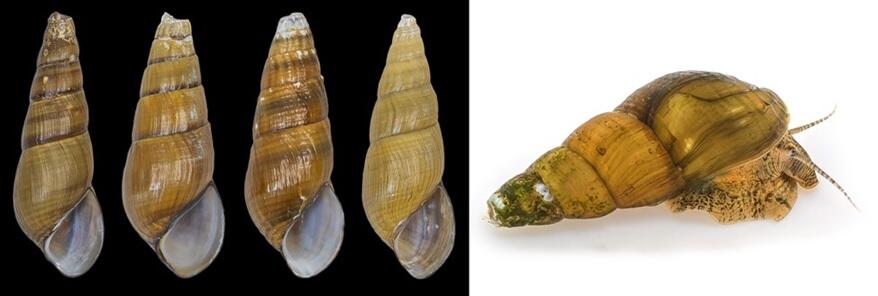In Lake Biwa, an ancient lake, the freshwater snail genus Semisulcospira has undergone diverse evolutionary adaptation. Most of these species with their origin in Lake Biwa are still distributed only in the local system. S. kurodai is the only exception, and this species is known to have a wide distribution range from Shizuoka Prefecture to Okayama Prefecture. In S. kurodai, previous studies have found four genetically distinct intraspecific subgroups, but they had not been fully evaluated as to whether they are independent species.
A research group including Doctoral Student Naoto Sawada (at the time of the study; currently a project researcher of the Graduate School of Science at the University of Tokyo), Doctoral Student Yusuke Fuke (at the time of the study; currently a JSPS postdoctoral fellow at the National Institute of Genetics) of the Graduate School of Science at Kyoto University, and Professor Osamu Miura of the Faculty of Agriculture and Marine Science at Kochi University, conducted genetic analysis and AI-based morphological analysis of S. kurodai. Based on the analysis results, the research group has redefined the taxonomic position of S. kurodai and described three new species, S. masudai (distributed in Hyogo and Tottori Prefectures), S. praecursa (distributed in Shizuoka and Aichi Prefectures), and S. miurai (distributed in Okayama Prefecture). The study was published in Systematics and Biodiversity.

Provided by the University of Tokyo
The research group searched for S. kurodai at 37 sites in the Tokai, Kinki, Chugoku, and Shikoku regions. At 26 of these sites, they collected specimens and investigated habitats. Combining the 118 S. kurodai specimens with data from previous studies, they performed genetic analysis based on single nucleotide polymorphisms obtained by reduced-representation genome sequencing using the MIG-seq method. As a result, three genetically distinct subgroups of the S. niponica group and one subgroup of the S. nakasekoae group were found within the species S. kurodai.
Next, to identify morphological differences among these four subgroups, they conducted a discriminant analysis using machine learning (random forest method) and found that the angle and sculpture morphology of adult shells and the size of embryonic shells were useful for species identification. They also compared radula morphologies and found that the radula morphology discriminated some of the four genetic subgroups.
As the four genetic subgroups of S. kurodai were also morphologically distinct from each other, they were considered to be four independent species, of which three other than S. kurodai were undescribed species. However, previous studies have found two genetic subgroups in the type locality of S. kurodai, and it has remained unclear which subgroup is the true S. kurodai. Therefore, the research group used morphological analysis to predict the morphological similarity between the specimens collected in this study and the type specimens of S. kurodai and concluded that the subgroup with the widest distribution was the true S. kurodai.
Sawada said, "When I started studying the genus Semisulcospira, I often wondered, 'Is S. kurodai of the S. niponica group really the only Semisulcospira species that migrated from Lake Biwa? I hope there is similarly the dream scenario of species in the S. nakasekoae group also doing so. I feel happy that we could taxonomically clarity the unexpected species diversity hidden in S. kurodai in this study and make my dream about S. miurai a reality. Moving forward, I will build on the results of this study and continue to pursue the clarification of the evolutionary history of the genus Semisulcospira from multiple perspectives."
Journal Information
Publication: Systematics and Biodiversity
Title: Integrative taxonomy of Semisulcospira kurodai (Mollusca, Semisulcospiridae) with insights into its geographic variation and description of three new species from Japan
DOI: 10.1080/14772000.2024.2436684
This article has been translated by JST with permission from The Science News Ltd. (https://sci-news.co.jp/). Unauthorized reproduction of the article and photographs is prohibited.




